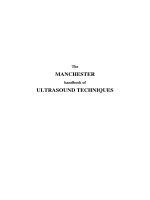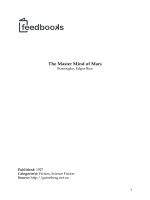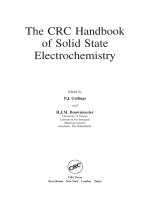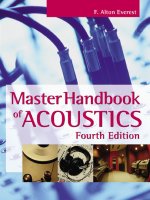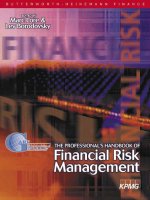- Trang chủ >>
- Khoa Học Tự Nhiên >>
- Vật lý
everest f.a. the master handbook of acoustics
Bạn đang xem bản rút gọn của tài liệu. Xem và tải ngay bản đầy đủ của tài liệu tại đây (5.5 MB, 641 trang )
THE MASTER HANDBOOK
OF ACOUSTICS
This page intentionally left blank.
THE MASTER HANDBOOK
OF ACOUSTICS
F. Alton Everest
FOURTH EDITION
McGraw-Hill
New York San Francisco Washington, D.C. Auckland Bogotá
Caracas Lisbon London Madrid Mexico City Milan
Montreal New Delhi San Juan Singapore
Sydney Tokyo Toronto
Copyright © 2001 by The McGraw-Hill Companies, Inc. All rights reserved. Manufactured in the United States of America. Except as
permitted under the United States Copyright Act of 1976, no part of this publication may be reproduced or distributed in any form or by
any means, or stored in a database or retrieval system, without the prior written permission of the publisher.
0-07-139974-7
The material in this eBook also appears in the print version of this title: 0-07-136097-2.
All trademarks are trademarks of their respective owners. Rather than put a trademark symbol after every occurrence of a trademarked name, we use names in an editorial fashion only, and to the benefit of the trademark owner, with no intention of infringement of the trademark. Where such designations appear in this book, they have been printed with initial caps.
McGraw-Hill eBooks are available at special quantity discounts to use as premiums and sales promotions, or for use in corporate
training programs. For more information, please contact George Hoare, Special Sales, at or (212)
904-4069.
TERMS OF USE
This is a copyrighted work and The McGraw-Hill Companies, Inc. (“McGraw-Hill”) and its licensors reserve all rights in and to the
work. Use of this work is subject to these terms. Except as permitted under the Copyright Act of 1976 and the right to store and
retrieve one copy of the work, you may not decompile, disassemble, reverse engineer, reproduce, modify, create derivative works
based upon, transmit, distribute, disseminate, sell, publish or sublicense the work or any part of it without McGraw-Hill’s prior consent. You may use the work for your own noncommercial and personal use; any other use of the work is strictly prohibited. Your right
to use the work may be terminated if you fail to comply with these terms.
THE WORK IS PROVIDED “AS IS”. McGRAW-HILL AND ITS LICENSORS MAKE NO GUARANTEES OR WARRANTIES
AS TO THE ACCURACY, ADEQUACY OR COMPLETENESS OF OR RESULTS TO BE OBTAINED FROM USING THE
WORK, INCLUDING ANY INFORMATION THAT CAN BE ACCESSED THROUGH THE WORK VIA HYPERLINK OR
OTHERWISE, AND EXPRESSLY DISCLAIM ANY WARRANTY, EXPRESS OR IMPLIED, INCLUDING BUT NOT LIMITED
TO IMPLIED WARRANTIES OF MERCHANTABILITY OR FITNESS FOR A PARTICULAR PURPOSE. McGraw-Hill and its
licensors do not warrant or guarantee that the functions contained in the work will meet your requirements or that its operation will
be uninterrupted or error free. Neither McGraw-Hill nor its licensors shall be liable to you or anyone else for any inaccuracy, error
or omission, regardless of cause, in the work or for any damages resulting therefrom. McGraw-Hill has no responsibility for the content of any information accessed through the work. Under no circumstances shall McGraw-Hill and/or its licensors be liable for any
indirect, incidental, special, punitive, consequential or similar damages that result from the use of or inability to use the work, even
if any of them has been advised of the possibility of such damages. This limitation of liability shall apply to any claim or cause whatsoever whether such claim or cause arises in contract, tort or otherwise.
DOI: 10.1036/0071399747
To Bonnie Gail, whose love of art, nature, and the author
now embraces acoustics.
This page intentionally left blank.
CONTENTS
Epigraph
Introduction
Chapter 1
xxi
xxiii
Fundamentals of Sound
1
The Simple Sinusoid
2
Sine-Wave Language
Propagation of sound
The dance of the particles
How a sound wave is propagated
Sound in free space
Wavelength and Frequency
Complex Waves
Harmonics
Phase
Partials
Octaves
The concept of spectrum
Electrical, Mechanical, and Acoustical Analogs
12
12
12
15
15
17
20
Sound Levels and the Decibel
23
Ratios vs. Differences
Handling numbers
Logarithms
23
25
26
Decibels
26
Reference Levels
28
Logarithmic and Exponential Forms Compared
30
Acoustic Power
Chapter 2
3
5
5
7
9
10
31
Copyright 2001 The McGraw-Hill Companies, Inc. Click Here for Terms of Use.
viii
CONTENTS
Using Decibels
Example: Sound-pressure level
Example: Loudspeaker SPL
Example: Microphone specifications
Example: Line amplifier
Example: General-purpose amplifier
Example: Concert hall
Example: Combining decibels
Ratios and Octaves
Measuring Sound-Pressure Level
Chapter 3
33
34
34
35
35
35
35
36
37
39
The Ear and the Perception of Sound
41
Sensitivity of the Ear
41
A Primer of Ear Anatomy
The pinna: Directional encoder of sound
Directional cues: An experiment
The ear canal
The middle ear
The inner ear
Stereocilia
Loudness vs. Frequency
42
43
44
44
45
48
49
50
Loudness Control
51
Area of Audibility
53
Loudness vs. Sound-Pressure Level
54
Loudness and Bandwidth
56
Loudness of Impulses
59
Audibility of Loudness Changes
61
Pitch vs. Frequency
An experiment
Timbre vs. Spectrum
61
63
63
Localization of Sound Sources
64
Binaural Localization
Aural harmonics: Experiment #1
Aural harmonics: Experiment #2
The missing fundamental
The Ear as an Analyzer
67
68
69
69
70
The Ear as a Measuring Instrument
An auditory analyzer: An experiment
70
71
CONTENTS
Meters vs. the Ear
The Precedence Effect
75
Occupational and Recreational Deafness
76
Summary
79
Sound Waves in the Free Field
83
Free Sound Field: Definition
83
Sound Divergence
Examples: Free-field sound divergence
Inverse square in enclosed spaces
Hemispherical propagation
Chapter 5
73
Perception of Reflected Sound
Chapter 4
72
84
84
87
88
Speech, Music, and Noise
89
The Voice System
Artificial larynx
Sound spectrograph
Sound sources for speech
Vocal tract molding of speech
Formation of voiced sounds
Formation of unvoiced sounds
Putting it all together
Synthesized speech
Digital speech synthesis
Directionality of speech
Music
Wind instruments
Nonharmonic overtones
Dynamic range of speech and music
Power in Speech and Music
89
89
90
92
92
94
95
95
96
97
98
99
101
101
101
103
Frequency Range of Speech and Music
104
Future Dynamic-Range Requirements
104
Auditory Area
104
Noise
Noise—The good kind
Random noise
White and pink noise
Signal Distortion
107
108
109
111
112
Harmonic Distortion
114
ix
x
CONTENTS
Chapter 6
119
Resonance
120
Filters
Active filters
Analog vs. digital filters
Digitization
Quantization
Digital filters
Application of Digital Signal Processing (DSP)
122
123
124
125
126
126
105
Application of DSP to Room Equalization
Chapter 7
Analog and Digital Signal Processing
106
Reverberation
129
Reverberation and Normal Modes
130
Growth of Sound in a Room
132
Decay of Sound in a Room
134
Idealized Growth and Decay of Sound
134
Reverberation Time
135
Measuring Reverberation Time
137
Impulse Sound Sources
137
Steady-State Sources
138
Equipment
138
Measurement Procedure
Analysis of decay traces
Mode Decay Variations
Writing speed
Frequency effect
Reverberation Time Variation with Position
140
140
142
143
144
145
Acoustically Coupled Spaces
146
Electroacoustically Coupled Spaces
Decay rate
Eliminating decay fluctuations
Influence of Reverberation on Speech
146
147
147
148
Influence of Reverberation on Music
149
Optimum Reverberation Time
Bass rise of reverberation time
Living room reverberation time
150
152
154
CONTENTS
Artificial Reverberation: The Past
Artificial Reverberation: The Future
157
The Sabine Equation
Reverberation calculation: Example 1
Reverberation calculation: Example 2
Reverberant Field
159
160
162
162
Control of Interfering Noise
165
Noise Sources and Some Solutions
Airborne noise
Noise carried by structure
Noise transmitted by diaphragm action
Sound-insulating walls
Porous materials
Sound Transmission Classification (STC)
166
167
167
168
168
169
170
Comparison of Wall Structures
171
Double Windows
173
Sound-Insulating Doors
Noise and room resonances
Active noise control
Chapter 9
156
Arrival Time Gap
Chapter 8
155
175
176
177
Absorption of Sound
179
Dissipation of Sound Energy
179
Evaluation of Sound Absorption
181
Reverberation Chamber Method
182
Impedance Tube Method
182
Tone-Burst Method
185
Mounting of Absorbents
186
Mid/High Frequency Absorption by Porosity
Glass fiber: Building insulation
Glass fiber: Boards
Acoustical tile
Effect of Thickness of Absorbent
187
189
190
190
190
Effect of Airspace behind Absorbent
191
Effect of Density of Absorbent
192
xi
xii
CONTENTS
Open-Cell Foams
Drapes as Sound Absorbers
193
Carpet as Sound Absorber
Effect of carpet type on absorbance
Effect of carpet underlay on absorbance
Carpet absorption coefficients
Sound Absorption by People
196
199
200
200
200
Absorption of Sound in Air
203
Low-Frequency Absorption by Resonance
203
Diaphragmatic Absorbers
205
Polycylindrical Absorbers
209
Poly Construction
212
Membrane Absorbers
213
Helmholtz Resonators
215
Perforated Panel Absorbers
218
Slat Absorbers
224
Placement of Materials
225
Reverberation Time of Helmholtz Resonators
Taming room modes
Increasing Reverberation Time
225
226
229
Modules
Chapter 10
192
229
Reflection of Sound
235
Reflections from Flat Surfaces
235
Doubling of Pressure at Reflection
237
Reflections from Convex Surfaces
237
Reflections from Concave Surfaces
237
Reflections from Parabolic Surfaces
238
Reflections inside a Cylinder
240
Standing Waves
240
Reflection of Sound from Impedance
Irregularities
240
The Corner Reflector
243
Echo-Sounding
243
Perceptive Effects of Reflections
244
CONTENTS
Chapter 11
245
Diffraction and Wavelength
246
Diffraction of Sound by Large and Small Apertures
247
Diffraction of Sound by Obstacles
248
Diffraction of Sound by a Slit
249
Diffraction by the Zone Plate
250
Diffraction around the Human Head
251
Diffraction by Loudspeaker Cabinet Edges
253
Diffraction by Various Objects
254
Refraction of Sound
257
Refraction of Sound
Refraction of sound in solids
Refraction of sound in the atmosphere
Refraction of sound in the ocean
Refraction of sound in enclosed spaces
Chapter 13
245
Rectilinear Propagation
Chapter 12
Diffraction of Sound
258
258
260
263
265
Diffusion of Sound
267
The Perfectly Diffuse Sound Field
267
Evaluating Diffusion in a Room
Steady-state measurements
Decay Beats
268
268
269
Exponential Decay
270
Spatial Uniformity of Reverberation Time
271
Decay Shapes
275
Microphone Directivity
275
Room Shape
275
Splaying Room Surfaces
Nonrectangular rooms
Geometrical Irregularities
281
281
282
Absorbent in Patches
282
Concave Surfaces
286
Convex Surfaces: The Poly
286
Plane Surfaces
287
xiii
xiv
CONTENTS
Chapter 14
289
Schroeder’s First Acoustic Diffusor
290
Maximum-Length Sequences
292
Reflection Phase-Grating Diffusors
292
Quadratic-Residue Diffusors
293
Primitive-Root Diffusors
296
Quadratic-Residue Applications
298
Performance of Diffraction-Grating Diffusors
Expansion of the QRD line
Solving flutter problems
Application of fractals
Diffusion in three dimensions
Acoustic concrete blocks
Measuring diffusion efficiency
Comparison of Gratings with Conventional
Approaches
Chapter 15
The Schroeder Diffusor
298
304
304
306
308
309
311
312
Modal Resonances in Enclosed Spaces
317
Resonance in a Pipe
318
Bathroom Acoustics
319
Reflections Indoors
320
Two-Wall Resonance
322
Waves vs. Rays
322
Frequency Regions
323
Dividing the Audio Spectrum
325
Wave Acoustics
Mode calculations—An example
Experimental Verification
326
328
331
Mode Identification
331
Mode Decay
333
Mode Bandwidth
334
Mode Pressure Plots
339
Modal Density
341
Mode Spacing and Coloration
342
Experiments with Colorations
344
Simplified Axial Mode Analysis
346
CONTENTS
The Bonello Criterion
Controlling Problem Modes
Reflections in Enclosed Spaces
353
353
Mean Free Path
The effect of single reflections
Perception of sound reflections
Perception of spaciousness
Image changes
Discrete echoes
Effect of angle of incidence on audibility
of reflection
Effect of signal type of audibility of reflection
Effect of spectrum on audibility of reflection
Using reflection data
Large Spaces
Echoes
Spaciousness
354
355
355
357
357
357
357
358
358
359
359
359
360
Comb-Filter Effects
363
What Is a Comb Filter?
363
Superposition of Sound
364
Tonal Signals and Comb Filters
Combing of music and speech signals
Combing of direct and reflected sound
Comb Filters and Critical Bands
365
367
368
371
Comb Filters in Stereo Listening
374
Coloration and Spaciousness
374
Combing in Stereo Microphone Pickups
375
Audibility of Comb-Filter Effects
Comb filters in practice
Estimating comb-filter response
Chapter 18
350
Law of the First Wavefront
Chapter 17
348
Mode Summary
Chapter 16
348
375
376
380
Quiet Air for the Studio
385
Selection of Noise Criterion
386
Fan Noise
388
xv
xvi
CONTENTS
ASHRAE
Machinery Noise
390
Effect of Terminal Fittings
391
“Natural” Attenuation
391
Duct Lining
392
Plenum Silencers
393
Packaged Attenuators
394
Reactive Silencers
394
Resonator Silencer
395
Duct Location
395
Some Practical Suggestions
395
Acoustics of the Listening Room
399
The Acoustical Link
399
Peculiarities of Small-Room Acoustics
Room size
Room proportions
Reverberation time
The Listening Room: Low Frequencies
Control of modal resonances
Bass traps for the listening room
Modal colorations
The Listening Room: The Mid-High Frequencies
Identification and treatment of
reflection points
Lateral reflections: Control of spaciousness
Chapter 20
390
Air Velocity
Chapter 19
389
400
401
401
403
403
406
406
408
409
Acoustics of the Small Recording Studio
415
Acoustical Characteristics of a Studio
416
Reverberation
418
Studio Design
419
Studio Volume
419
Room Proportions
421
Reverberation Time
422
411
413
CONTENTS
Diffusion
Noise
424
Some Studio Features
424
Elements Common to all Studios
427
Acoustics of the Control Room
429
The Initial Time-Delay Gap
429
The Live End
431
Specular Reflections vs. Diffusion
432
Low-Frequency Resonances in the Control Room
434
Initial Time-Delay Gaps in Practice
436
Managing Reflections
438
The Reflection-Free-Zone Control Room
439
Control-Room Frequency Range
441
Outer Shell of the Control Room
442
Inner Shell of the Control Room
442
Representative Control Rooms
442
Some European Designs
444
Consultants
Chapter 22
424
Studio Design Procedure
Chapter 21
423
450
Acoustics for Multitrack Recording
453
Flexibility
545
Advantages of Multitrack
455
Disadvantages of Multitrack
456
Achieving Track Separation
457
Studio Acoustics
Distance between artists
Microphone management
Barriers for separation
Electronic separation
Electronic instruments and separation
The Future of Multichannel
458
458
458
459
459
459
460
Automation
460
xvii
xviii
CONTENTS
Chapter 23
468
468
468
469
Adjustable Acoustics
473
Draperies
Adjustable Panels: Absorption
Adjustable Panels: The Abffusor™
Hinged Panels
Louvered Panels
Variable Resonant Devices
Rotating Elements
Portable Units: The Tube Trap™
Portable Units: The Korner Killer™
473
474
476
478
479
480
483
484
485
Acoustical Distortion
489
Acoustic Distortion and the Perception of Sound
489
Sources of Acoustic Distortion
Coupling of room modes
Speaker-boundary interference response
Comb filtering
Poor diffusion
Conclusion
Chapter 26
462
462
462
463
463
464
465
465
The Voice-Over Booth
Dead-End Live-End Voice Studio
Voice-Over Booths
The Quick Sound Field™
Chapter 25
461
Selection of Space: External Factors
Selection of Space: Internal Factors
Work Space Treatment
Audio/Video Work Place Example
Appraisal of Room Resonances
Control of room resonances
Treatment of work place
Calculations
Chapter 24
Audio/Video Tech Room and Voice-Over
Recording
490
490
491
493
498
500
Room Acoustics Measurement Software
501
The Evolution of Measurement Technologies
502
CONTENTS
Building a Better Analyzer
Time-delay spectrometry (TDS) measurement
techniques
Maximum-length sequence (MLS) techniques
AcoustiSoft’s ETF Program
Frequency-response measurements
Resonance measurements
Fractional-octave measurements
Energy-time curve measurements
Reverberation time
Conclusion
Room Optimizer
529
529
Modal Response
530
Speaker-Boundary Interference Response
531
Optimization
533
Theory
Prediction of room response
Optimizing procedure
Cost parameter
Optimization Procedure
536
536
541
543
545
Results
Stereo pair
Stereo pair with two woofers per loudspeaker
THX home theater
Multichannel music
Subwoofer
Conclusion
Chapter 28
504
508
509
513
517
520
521
524
526
Introduction
Chapter 27
504
549
549
550
551
554
556
558
Desktop Auralization
565
Introduction
565
The Auralization Process
569
Summary
581
Appendix
585
Glossary
589
Index
599
xix
This page intentionally left blank.
EPIGRAPH
Directly or indirectly, all questions connected with this subject must
come for decision to the ear, as the organ of hearing; and from it there
can be no appeal. But we are not therefore to infer that all acoustical
investigations are conducted with the unassisted ear. When once we
have discovered the physical phenomena which constitute the foundation of sound, our explorations are in great measure transferred to
another field lying within the dominion of the principles of Mechanics.
Important laws are in this way arrived at, to which the sensations of
the ear cannot but conform.
Lord Raleigh in The Theory of Sound,
First Edition 1877.
(Also in first American edition, 1945,
courtesy of Dover Publications Inc.)
Copyright 2001 The McGraw-Hill Companies, Inc. Click Here for Terms of Use.
This page intentionally left blank.
INTRODUCTION
Excerpts from the introduction to the third edition.
In 1981, the copyright year of the first edition of this book, Manfred
Schroeder was publishing his early ideas on applying number theory
to the diffusion of sound. In the third edition a new chapter has been
added to cover numerous applications of diffraction-grating diffusors
to auditoriums, control rooms, studios and home listening rooms.
Introduction to the fourth edition.
The science of acoustics made great strides in the 20th century, during
which the first three editions of this book appeared. This fourth edition, however, points the reader to new horizons of the 21st century. A
newly appreciated concept of distortion of sound in the medium itself
(Chap. 25), a program for acoustic measurements (Chap. 26), and the
optimization of placement of loudspeakers and listener (Chap. 27), all
based on the home computer, point forward to amazing developments
in acoustics yet to come.
As in the previous three editions, this fourth edition balances treatment of the fundamentals of acoustics with the general application of
fundamentals to practical problems.
F. Alton Everest
Santa Barbara
Copyright 2001 The McGraw-Hill Companies, Inc. Click Here for Terms of Use.
This page intentionally left blank.


